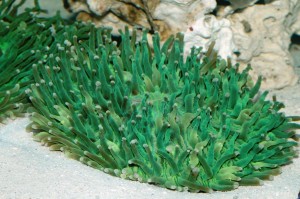Reef keeping has developed over the years from a hobby to a piece of attraction to be kept at home. The amount of money an enthusiast spends on reef maintaining and adding substantial anemones and corals to them are for the reason that they enjoy nurturing them. On the other hand folks that are more into reef keeping because of its beauty added to their living room are more concerned with the attractiveness of the tank, hence paying more attention to making it multihued and luring.
Playing with colors to make reef tanks attractive is nothing wrong. Of course we all love to see them lively with a lot of colors. What goes wrong is when you overlook the quality of the dyed corals while adding them to reef tank. Some of them are so beautifully painted that you just cannot say no to them. They look more natural and are eye catching. One look at them and you will be tempted to get them. However, take some time to know if they are apt for your tank and will its color last? Question their original color and imagine how they are going to look once the color that is the base of attraction fades.
Both soft and stony colors are being tinted in unnatural colors of pink, magenta and bright yellow. A skilled aquarist will recognize them instantly and would surely abstain from them. The newbie makes mistake of believing them to be naturally tinted and adding them without researching on them. Most commonly seen dyed corals are Leather/Finger coral (Sinularia), Colt coral (Klyxum), Cup coral (Turbinaria peltata), Flowerpot coral (Goniopora), Trumpet coral (Caulastrea), and sebae and carpet anemones.
Any good retailer of aquatic products will inform you if it is natural or just painted. However, most retailers are simply concerned about adding customers. They make false promises of the color being natural and sometimes they say that the color is non-toxic and will cause no harm in any way. The best way is to research on the coral before shopping for it. You can find out what are its natural colors in which they should be available to you according to your location. This way you will know if you see the same in some unrealistic tint of blue or red. The tank is yours. The expenses you are putting in it is your hard earned money and the corals and invertebrates you have nurtured in your tank are dear to you. You obviously don’t want to waste them for some artificial painted coral that will not only die but also harm your tank’s previously nurtured contents. So, the duty is also yours to learn about them before getting lured. You will have none to blame after the disaster has been caused. Neither the retailer nor the manufacturer will be of any help if you complain. Do some homework before stepping into the shops and some research before finally paying off.
Dying, bleaching or painting not only lessens the lifespan of the coral but also make it stressed and a source of disease for the environment it will be added in. Stressed corals and anemones will come out to have a thin or watery countenance as with yellow or lime colors in naturally green specimens and tan or crème colors in once brown pigmented ones. The most rigorously stressed anemones will appear to be white colored. Bright colored tips will remain if they were natural in the beginning, as they commonly are not a zooxanthellate tincture or willingly aborted under duress. With no zooxanthellae to provide food through photosynthesis with adequate light, a bleached coral is reconciled to starve to death in weeks or months without unusual attentiveness from an aquarist with compensatory feeding of particulate or dissolved foods to the dyed victim.
In the early days of being dyed the corals and anemones continue to develop and fight with the changes and adapt to it but unfortunately, it yield no result and they die after a certain period of time. The only good thing that you can expect to happen to it is when the dye starts to fade; they might recover with healthy feeding and adequate lighting. But that happens in rare case and they hardly revert to their normal healthy living. Is it not a kind of exploitation to these animals? Killing them just for the purpose of earning some fat money is inhuman undoubtedly. The death that comes with the dying of corals and anemones is slow but indeed a shame of how they are being traded so cruelly. Say no to buying the dyed corals if you feel for these creatures; Perhaps that might make a difference to the torment they are made to suffer.





